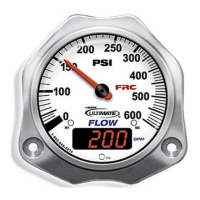FP4000 Rev0204
10
Install Flow Sensor
There are several ways to install FRC paddlewheel type flow sensors. Mounting
options include saddle clamps, weldments, pipe tees, and special adapters. Each mount
will meet particular plumbing requirements.
Flow sensors are interchangeable. It is recommended that the calibration be checked
if flow sensors are swapped.
The maximum pressure for a flow sensor installation is 600 PSI.
Flow Sensor Location
The location of the flow sensor in the plumbing system is critical. The flow of
water at and around the sensor must be laminar, or smooth, to ensure accurate flow
rate measurement. There must be enough straight pipe run before the flow sensor location
to allow the water stream to stabilize into a uniform flow. Guidelines for selecting flow
sensor locations are outlined in Figure 3.
When the sensor is mounted after an area in the plumbing that tends to increase
water stream turbulence (a valve, increase in pipe diameter, etc.), it is critical that steps
are taken to stabilize the flow.
• When a pipe is reduced in diameter the water stream tends to be squeezed
into a more uniform flow. This can be used to help stabilize flow when
there is not a sufficient pipe run up stream.
• FRC offers an optional flow conditioner that replaces the standard sensor
housing. It protrudes into the water stream at the sensor location and is
specially shaped to reduce local turbulence.
Linearizer Feature
FRC features a Linearizer function in the calibration programming. This function
should be used when the flow sensor is installed in a plumbing location where flow is
not linear. It corrects for nonlinear flow by allowing the display to be calibrated at
multiple flow rates (up to 10) to provide a more accurate flow rate display. (Refer to
Calibration section.)

